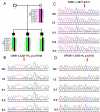Lack of phenotypic effect of triallelic variation in SPATA7 in a family with Leber congenital amaurosis resulting from CRB1 mutations
- PMID: 22219627
- PMCID: PMC3247167
Lack of phenotypic effect of triallelic variation in SPATA7 in a family with Leber congenital amaurosis resulting from CRB1 mutations
Abstract
Purpose: To identify the causative gene for autosomal recessive Leber congenital amaurosis (LCA) in a Chinese family.
Methods: One Chinese LCA family was identified and an ophthalmologic examination was performed. The genetic defects were analyzed simultaneously by a genome-wide linkage scan with 382 polymorphic microsatellite markers, as well as by comprehensive mutational screening of 15 genes known to associate with LCA on the genomic DNA of this family.
Results: Suggestive linkages were found in 13 chromosomal regions, of which only one harbored a known causative gene, crumbs homolog 1 (CRB1), on chromosome 1. Sanger sequencing of CRB1 identified two novel heterozygous mutations, c.3221T>C (p.L1074S) and c.2677-2A>C. In addition, a novel missense heterozygous mutation, c.938C>A (p.A313D), in spermatogenesis associated 7 (SPATA7), was detected in the proband after screening of the other 14 LCA causative genes. All three affected individuals of the family had compound heterozygous CRB1 mutations, and one of the three (the proband) had an additional mutation in SPATA7. The unaffected mother had the heterozygous c.3221T>C mutation in CRB1 and the heterozygous c.938C>A mutation in SPATA7. The unaffected father could not be tested, but presumably had the heterozygous c.2677-2A>C mutation in CRB1. The proband, with triallelic mutations in CRB1 and SPATA7, had a phenotype similar to other two affected brothers, suggesting the additional mutant allele in SPATA7 might not contribute to the disease. Similarly, the mother, with digenic mutations in CRB1 and SPATA7, had normal vision and fundi, suggesting the digenic mutations in these two genes might not cause disease.
Conclusions: Digenic and triallelic mutations of CRB1 and SPATA7 were detected in a family with LCA. Our results imply that CRB1 and SPATA7 may not interact with each other directly. This emphasizes that care should be taken in invoking a mutation-disease association for digenic and triallelic mutations.
Figures





Similar articles
-
A novel nonsense variant (c.1499C>G) in CRB1 caused Leber congenital amaurosis-8 in a Chinese family and a literature review.BMC Med Genomics. 2022 Sep 17;15(1):197. doi: 10.1186/s12920-022-01356-z. BMC Med Genomics. 2022. PMID: 36115989 Free PMC article. Review.
-
Molecular genetics with clinical characteristics of Leber congenital amaurosis in the Han population of western China.Ophthalmic Genet. 2021 Aug;42(4):392-401. doi: 10.1080/13816810.2021.1904417. Epub 2021 May 10. Ophthalmic Genet. 2021. PMID: 33970760
-
Novel mutations of CRB1 in Chinese families presenting with retinal dystrophies.Mol Vis. 2014 Mar 26;20:359-67. eCollection 2014. Mol Vis. 2014. PMID: 24715753 Free PMC article.
-
Clinical and genetic characteristics of Leber congenital amaurosis with novel mutations in known genes based on a Chinese eastern coast Han population.Graefes Arch Clin Exp Ophthalmol. 2016 Nov;254(11):2227-2238. doi: 10.1007/s00417-016-3428-5. Epub 2016 Jul 16. Graefes Arch Clin Exp Ophthalmol. 2016. PMID: 27422788
-
CRB1-Related Leber Congenital Amaurosis: Reporting Novel Pathogenic Variants and a Brief Review on Mutations Spectrum.Iran Biomed J. 2019 Sep;23(5):362-8. doi: 10.29252/.23.5.362. Epub 2019 May 19. Iran Biomed J. 2019. PMID: 31103025 Free PMC article. Review.
Cited by
-
Mutations of 60 known causative genes in 157 families with retinitis pigmentosa based on exome sequencing.Hum Genet. 2014 Oct;133(10):1255-71. doi: 10.1007/s00439-014-1460-2. Epub 2014 Jun 18. Hum Genet. 2014. PMID: 24938718
-
A novel nonsense variant (c.1499C>G) in CRB1 caused Leber congenital amaurosis-8 in a Chinese family and a literature review.BMC Med Genomics. 2022 Sep 17;15(1):197. doi: 10.1186/s12920-022-01356-z. BMC Med Genomics. 2022. PMID: 36115989 Free PMC article. Review.
References
-
- Leber T. Uber retinitis pigmentosa und angeborene amaurose. Graefes Arch Klin Ophthalmol. 1869;15:1–25.
-
- den Hollander AI, Roepman R, Koenekoop RK, Cremers FP. Leber congenital amaurosis: genes, proteins and disease mechanisms. Prog Retin Eye Res. 2008;27:391–419. - PubMed
-
- Cremers FP, van den Hurk JA, den Hollander AI. Molecular genetics of Leber congenital amaurosis. Hum Mol Genet. 2002;11:1169–76. - PubMed
-
- Perrault I, Rozet JM, Calvas P, Gerber S, Camuzat A, Dollfus H, Chatelin S, Souied E, Ghazi I, Leowski C, Bonnemaison M, Le Paslier D, Frezal J, Dufier JL, Pittler S, Munnich A, Kaplan J. Retinal-specific guanylate cyclase gene mutations in Leber's congenital amaurosis. Nat Genet. 1996;14:461–4. - PubMed
-
- den Hollander AI, Heckenlively JR, van den Born LI, de Kok YJ, van der Velde-Visser SD, Kellner U, Jurklies B, van Schooneveld MJ, Blankenagel A, Rohrschneider K, Wissinger B, Cruysberg JR, Deutman AF, Brunner HG, Apfelstedt-Sylla E, Hoyng CB, Cremers FP. Leber congenital amaurosis and retinitis pigmentosa with Coats-like exudative vasculopathy are associated with mutations in the crumbs homologue 1 (CRB1) gene. Am J Hum Genet. 2001;69:198–203. - PMC - PubMed
Publication types
MeSH terms
Substances
LinkOut - more resources
Full Text Sources
Medical
Research Materials
